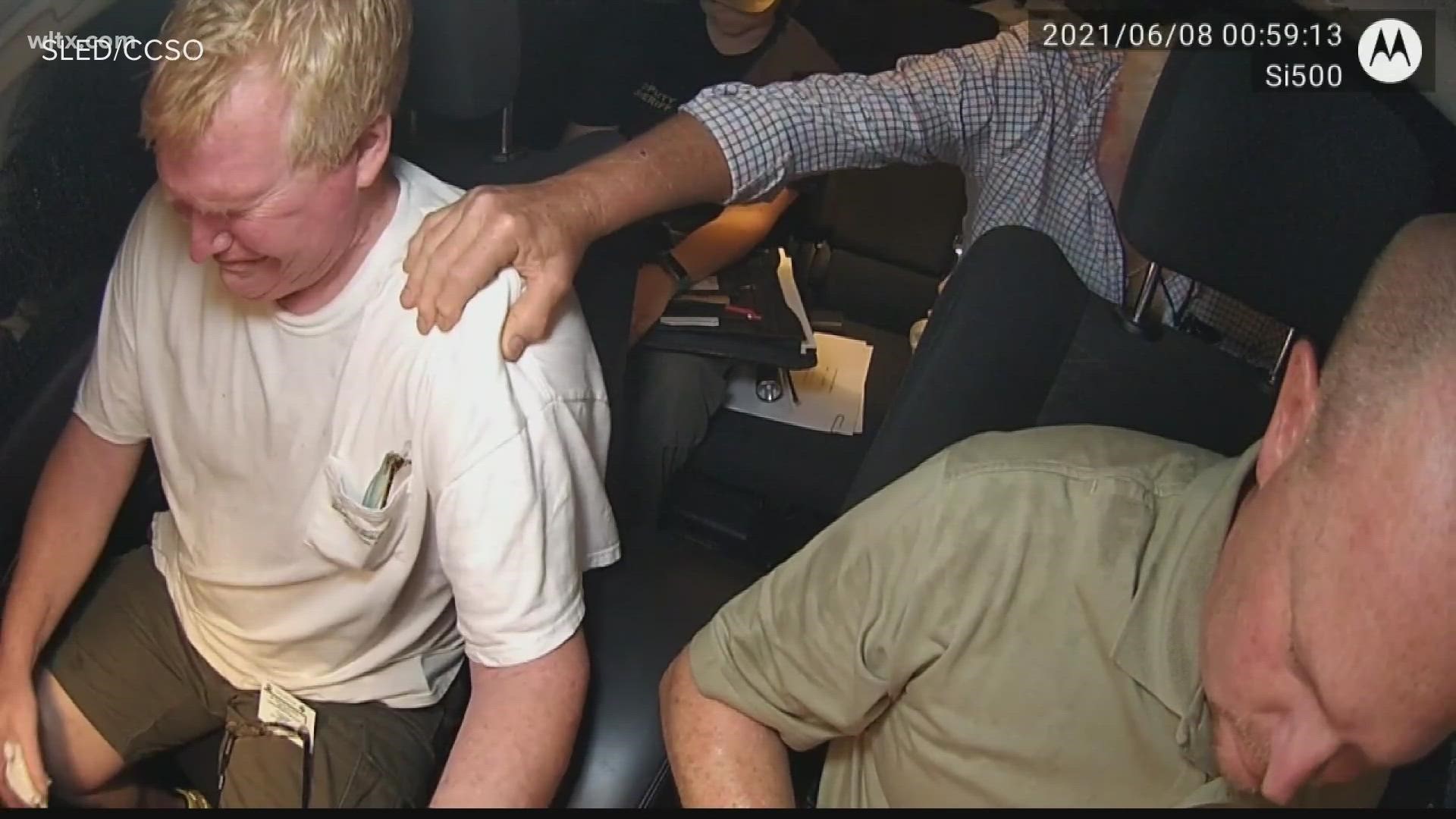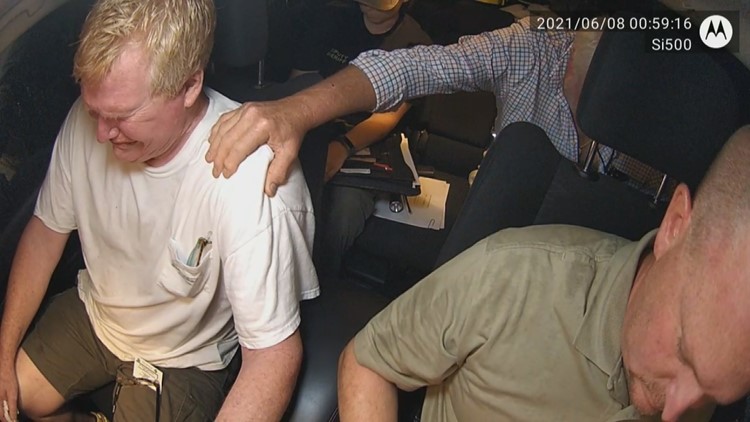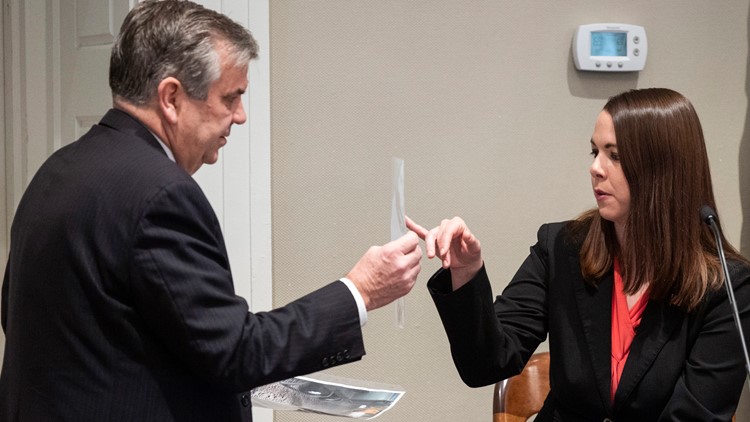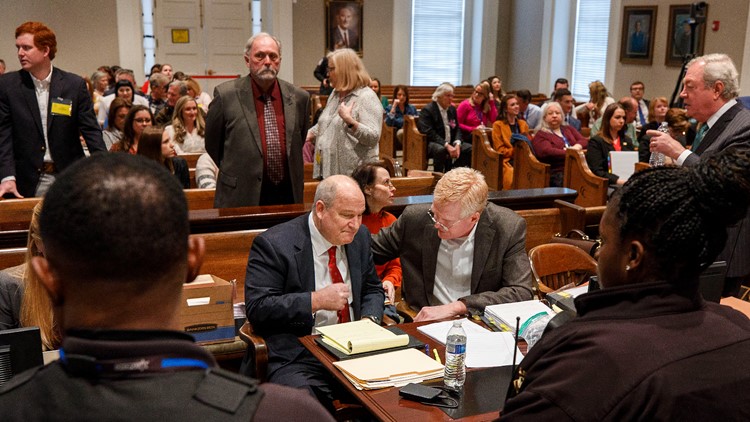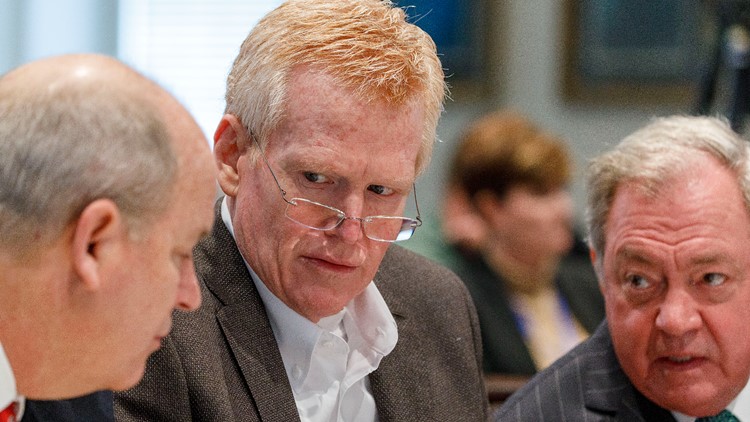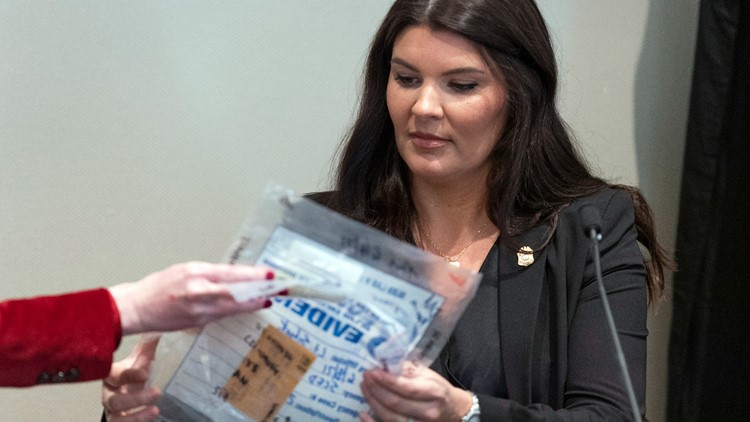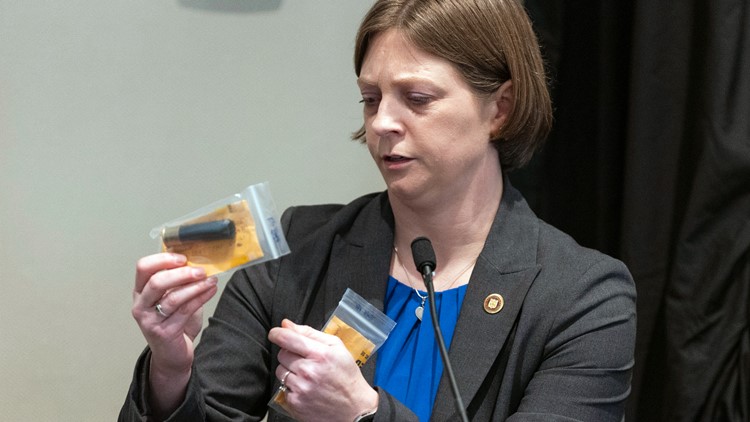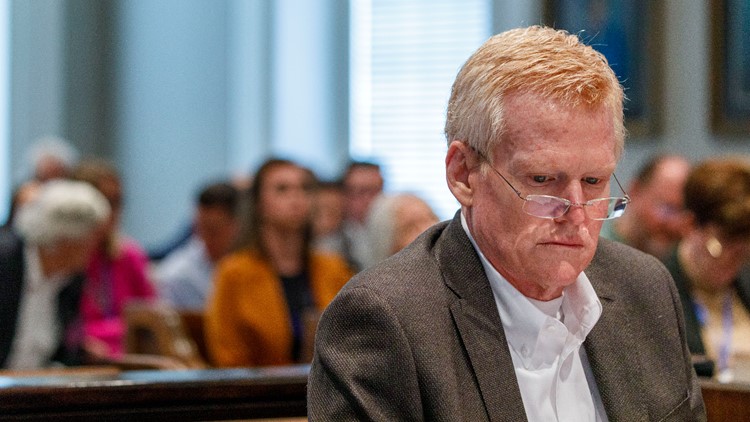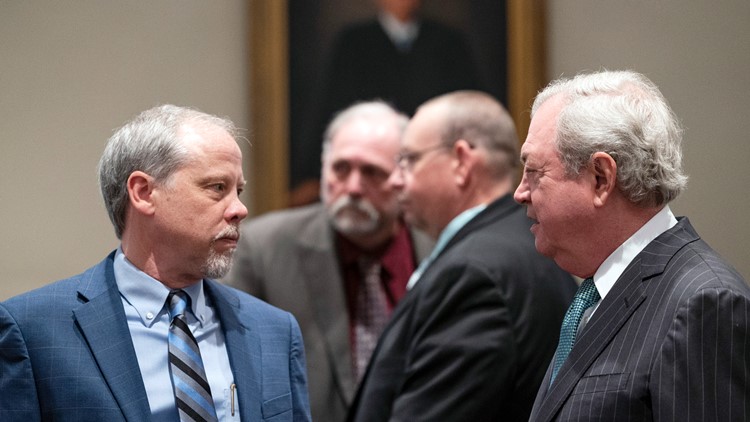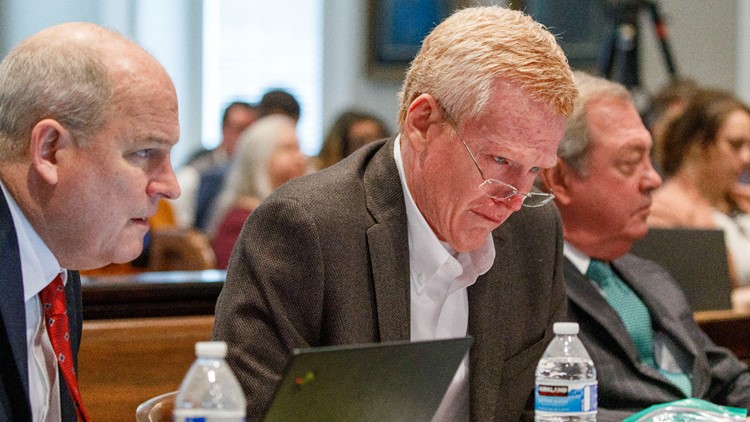WALTERBORO, S.C. — The second day of testimony in the Alex Murdaugh double murder trial has finished, with several criminal investigators taking the stand to describe what they found on the night that prosecutor say Murdaugh killed his wife and son.
Murdaugh is charged with shooting to death his wife, Maggie Murdaugh, and their adult son, Paul Murdaugh in 2021 at their sprawling family estate in rural Colleton County, South Carolina.
Thursday’s testimony focused on the first responders to the crime scene at Moselle property in Colleton County.
The court heard from Sgt. Daniel Greene, Cpl. Chad McDowell and Cpt. Jason Chapman of the Colleton County Sheriff’s Office. Those three men, along with Colleton County Fire and Rescue Fire Chief Barry McRoy were the first officers on the scene. They in turn described the scene – the position of Paul and Maggie Murdaugh’s bodies (some in graphic detail), where they found Alex Murdaugh, and how they began securing the scene before turning the case over to South Carolina Law Enforcement Division’s (SLED’s) crime scene unit.
The court also heard the 911 call made by Alex Murdaugh to dispatchers in Hampton and Colleton counties.
During both presentations, Murdaugh could be seeing crying.
Two discoveries came to light Thursday afternoon: tire tracks in the grass near the dog kennels where Maggie and Paul were found, and a set of footprints Chapman testified went around and behind the hangar used as a feed shed and back.
While the tire tracks have yet to be positively identified, the footprints, according to Chapman, are similar in shape, size and design to footwear work by Maggie Murdaugh at the time of her death.
Alex Murdaugh Trial Friday Latest Updates:
Detective Laura Rutland, Colleton County Sheriff’s Office
The State called Detective Laura Rutland of Colleton County Sheriff’s Office (CCSO) as it’s first witness of the day.
Rutland was on call June 7, 2021. She lives in Ridgeland, SC. She was called in for the Murdaugh case and was sent to CCSO to prepare the search warrant for Moselle, get it signed by a judge, and notify the team the warrant was ready for the SLED crime scene unit.
Arriving at the scene, Rutland testifies she was asked by detectives if she knew the Murdaugh family or anything about the boat accident involving Mallory Beach. She answered no and was assigned as liaison to SLED Special Agent David Owen.
At that point, she did not walk the crime scene but located Alex Murdaugh and his brother, Randy, and Murdaugh’s personal attorney Danny Henderson.
She observed inside the feed room, shotgun wadding, brain and body tissue on the ceiling and walls, busted windows in the feed room.
PHOTOS: Alex Murdaugh murder trial - Day 5
It was such a large scene, Rutland testifies, she used a flashlight to canvas the area outside of the feed room. Rutland found fresh shoe impressions behind the feed room. The smooth shoe prints appeared to go one way and come back, partially overlapping coming back the other way. She contacted her supervisor, and she and CCSO Cpt. Jason Chapman followed the footprints to determine the path the footprints took. (Chapman testified on Thursday)
In front of the hangar, Maggie is on the right, the footprints are on the left.
Rutland testifies she checked the shoes Maggie had on and they appeared to be similar to the footwear that left the footprints at the scene.
Rutland testifies Harpootlian contacted her about the footprints and showed her a photo and asked her if the treaded prints were hers and she answered they were not.
Rutland testifies she, Owen, Murdhaugh and Henderson went to a CCSO vehicle to talk and conduct an initial (recorded) interview with Alex. She says Murdaugh seemed to be NOT under the influence of alcohol or drugs and answered the questions put to him.
A recording of the interview is played for the court. Agent Owen is conducting the interview. Murdaugh says when he pulled up, he saw something bad had happened. Murdaugh breaks down crying after he says he saw Paul. He thinks he tried to turn Paul over and his cell phone popped out of his pocket. Alex says he picked it up and “tried to do something with it” before putting it back down. He says he went over to Maggie. He says he touched both bodies then called 911. Alex then called his brothers Randy and John and tried to call another friend but couldn’t get him.
Alex said in the interview, he went out to his mother’s house to check on her because she’s in late stages of Alzheimer’s and his father is in a hospital in Savannah.
He said Maggie was a dog lover and would be at the kennels. He tried to call and text Maggie and got no response. Paul was probably working on planting some sunflowers
On the recording, Alex states he and Paul and a good relationship and he and Maggie might have had some ups and downs but had a good relationship.
The only thing is, Alex says in the interview, is his son Paul was in a boat wreck and he was charged and arrested and there was some bad press about that, and Paul has been punched and hit and attacked a lot when he goes out in public. Murdaugh says he doesn’t know much of the details about the wreck, but Paul gets threats “all the time.” Mostly if he goes out, from what Alex understands.
Alex says on the recording there’s no one he is overly suspicious of, and this is “stupid.” He tells Owen his (unnamed) “groundskeeper told Paul a story how when he was younger, he got into a fight with some black guy and some FBI guys saw him fight and put him on a top-secret group with some Navy SEALS, who’s mission was to assassinate radical black activists.” Alex goes on to say, “the groundskeeper was off today but worked with Paul. Not that I think he did this.” Alex said the groundskeeper told the story to Paul sometime the week before. Paul was so taken aback by it, Alex says, that he recorded bits and pieces of the conversation. For all its weirdness, the groundskeeper and Paul got along well.
Owen asks about the boat incident, would anyone involved in the accident have a reason to go after Paul, and Alex says no. The threats came from people he didn’t know. He couldn’t defend himself in public and Alex says he’s “never been prouder of him and how he handled the situation. Paul was a wonderful, wonderful, wonderful kid.”
Alex says in the interview, Maggie had things to do in Charleston and a doctor’s appointment that day (Alex can’t remember the doctor’s name) and got to Moselle later in the afternoon (Alex thinks later than 6 p.m.). He adds, Paul worked with Alex’s brother John. Alex says Maggie loved the dogs and was probably playing with them, letting two of them run and it was a usual thing.
Alex says he was home, at the house, took a nap, called Maggie and didn’t get an answer, went to his mother’s house, texted Maggie and didn’t get an answer (around 9, when he left Moselle, and 9:47, when he was returning), tried contacting Paul.
Waters asks Rutland if she had listened to the 911 call before the interview with Alex. She said she had.
On the 911 call, Alex said he last saw Maggie two hours before and that he left the house that night to see his mother.
Rutland thought it strange Alex would visit his mother with Alzheimer’s at night because those patients typically get worse at night.
During the recorded interview, Alex told Owen and Rutland that Paul’s phone popped out of Paul’s pocket when he tried to turn him over.
Rutland is shown a photo of Maggie’s body and asked if Alex said he checked her body. Rutland said that is what Alex told her and Owen.
Rutland was asked if Alex said he tried to take the pulse of Paul and she responds, yes.
Blood and brain matter surround Paul and his arms are underneath him. Rutland was asked if Alex tried to take his pulse, would he have to roll the body – yes; if Alex tried to take the pulse at Paul’s neck, he would have to have moved his head – yes. There is blood and brains.
Rutland said she observed Alex when she arrived at the scene and during the interview with him – two hours after the 911 call -- and he was clean – no blood visible on his hands and arms, his shirt, pants or shoes.
ON CROSS
Defense attorney Jim Griffin asks Rutland if she recalls saying she thought it was unusual for Alex to check on his mother after 9 pm when she has Alzheimer’s. Alex’s father was put in the hospital that day. Certainly, she not criticizing a son for visiting an ill mother who was alone, is she?
No, Rutland says she was just taking mental notes.
As far as Alex being clean, Rutland testifies she saw no blood or tissue on Alex’s body or clothing.
Rutland testified she obtained the search warrant, and identifies the search warrant as it is entered into evidence. The warrant covered all of Moselle property, including outbuildings, sheds and vehicles on the property and allowed for the collection of evidence, including clothing, weapons, gunshot residue, footprints, drugs, DNA, phones, etc. found inside and outside the property in the course of a homicide investigation.
Griffin asks Rutland if she collected evidence that night, she testifies she was there in an assisting role to SLED Special Agent Owen. Owen was the investigator who collected Alex Murdaugh’s clothes.
Rutland testifies Alex said in the interview with she and Owen that he tried to turn Paul over but neither Rutland nor Owen asked Alex specifically how he attempted to turn Paul over.
Rutland testified nothing was done forensically on Alex’s clothing while she was at the scene.
Griffin goes over Rutland’s previous testimony about what she saw while observing Paul’s body – blood, brain matter, holes in the windows in the back wall; and Maggie’s body – blood spatter near or on the tires of a nearby ATV, a portion of a broken earring.
When asked about the boot prints on the photos of the footprint path behind the feed shed, Rutland reiterates the prints are not hers and she doesn’t know who they would belong to. She handed the search warrant off to SLED agents and believes the warrant was executed properly. She testifies when she left, the SLED crime scene unit was still processing the scene.
Griffin said Alex Murdaugh carte blanche consent to search his home and property.
Rutland testifies, over June 16-18, SLED agents searched the Moselle property, focusing on water on the property and locate the white Ford F-250. The truck that Paul used was in the possession of Alex's brother John Marvin. John Marvin had been driving it and the truck broke down on him while he was driving it.
Griffin asks Rutland about the position of the sheet covering Paul’s body. Rutland testifies when she observed the body, she could still see parts of the top of Paul’s head and body. Griffin asks about another photo with the sheet in a slightly different position. Rutland testifies that is not what she recalls seeing.
ON REDIRECT
Rutland reiterates she was in an assisting capacity to the SLED investigation and was present when SLED collected some evidence, processing of Alex Murdaugh’s vehicle, Maggie’s vehicle, when SLED teams searched water on the Moselle property.
Paul’s face was in gravel after falling forward away from the dog kennels.
Rutland says Alex Murdaugh appeared to be dressed in fresh clothing.
AGAIN, WITH DEFENSE
Griffin said it was beginning to rain that night and asks for the photo of Alex from that night. He asks Rutland if the clothes Alex is wearing appear to be clean. Rutland responds Alex is sweating and the clothes are clean.
Agent Dalila Cirencione, SLED crime scene unit
On June 8, Cirencione collected DNA swabbed evidence from Paul and Maggie Murdaugh. Once the DNA swabs were collected, Cirencione testifies she was sent to collect an iPhone for SLED forensics.
On cross, Harpootlian asks what role Cirencione had at SLED. She testifies that other than receiving the evidence, did not she collect any more evidence from the Moselle crime scene.
Harpootlian asks if Cirencione has heard of a Faraday bag? He explains a Faraday bag prevents signals from transmitting from your digital devices. Was Ciriencione given any special instructions about handling the iPhone, other than putting it in a brown paper bag, “like a can of pork and beans?”
Ciirencione responds, no, but it would depend on if the pork and beans was considered evidence.
Agent Melinda Worley, SLED crime scene unit
Worley focuses on footwear and tire tread identification and has testified as an expert witness on the topic.
As part of her work on the SLED crime scene unit, she helped process, photograph, document and establish a chain of evidence for items collected at the scene.
Worley arrived at Moselle around 12:07 a.m., after being notified around 10:30 p.m. The SLED team had to travel from Columbia to Colleton County and there was a light rain when the team arrived.
CCSO had marked some evidence before SLED arrived, and had taken custody of a loaded shotgun at the scene. Worley unloaded the gun to render it safe for transport.
Worley testifies she unloaded one 12-gauge and one 16-gauge shot from the 12-gauge shotgun.
Worley testifies the SLED team began processing the scenes around the bodies of the victims, taking photographs of the scene as it was when they arrived. She says photos were taken with the sheet on top of him and again when the sheet was removed. Worley says the object on the back of Paul’s shorts is his cell phone.
The team continues to process the scene inside the feed room, Worley says on the stand.
Worley is asked to describe what is in a series of photos of the crime scene. A marker is placed showing the position of shotgun wadding and blood and possible brain tissue on the floor of the feed shed and defects in the glass in the window on the wall. Blood and hair can be seen on top of the door to the feed room. Two fired shells and bits of hair behind the door in the feed room. Shotgun pellets on the floor and a partial bloody footprint.
The shot shells were photographed and collected, and a chain of evidence established as to date and time and where they were collected before sealing the evidence bag before transferring the shells to another agent at the scene.
Also in the feed room, there are two footprints in the feed room. Worley testifies she was able to compare the shoes Paul was wearing with the prints on the floor. Worley says in her opinion, the footprints in the feed room are consistent with the shoes Paul was wearing at the time of his murder.
Worley testifies there was a lot of blood and brain tissue on the top of the front of the door. There appears to be hair mixed in the blood and brain matter. There are holes in the window – six, she believes – on the back wall of the shed. Upon further examination of the defects in the window, Worley testifies she created a diagram of the window, showing the inside and outside of the window, measurements and where the defects were found. The “defects” are bullet holes in the glass, shown from the inside of the feed room.
Worley testified the team swabbed the exterior doorknob for touch DNA right before the court broke for lunch.
Court will resume at 2:20 p.m.
Testimony by SLED Agent Melinda Worley continued after Friday afternoon’s lunch break.
Prosecutor Savanna Goude continued her line of questioning for the State’s witness, asking Worley about items in the feed room, which Worley identified as pellets collected from the floor and the DNA swabs from the door.
Worley was asked if she observed Maggie’s body. She testifies, yes, and when she arrived Maggie’s body was covered by a sheet.
Goude asks Worley to describe the photos taken at the scene of Maggie’s body. Worley describes Maggie’s body on the ground near an ATV with the CCSO canopy covering it, shielding it from the elements. Paul’s body, covered with a pink sheet, can be seen in the background. Another photo shows Maggie’s body with the kennel and feed shed in the background.
Worley describes Maggie was face down with one arm beneath her body. When the body was moved, a 300 Blackout shell casing was found underneath her right knee.
Worley testifies other shell casings were collected at the scene – evidence markers were placed where the casings were found. A total of five 300 Blackout casings were recovered from the scene. Most of the evidence was transferred to SLED Agent Todd Schenk for logging in to record and secured for further analysis.
At marker 13 placed by CCSO, SLED dug into an area in the gravel thought to be a bullet strike and found metal fragments which Worley collected. Also discovered around Maggie’s body, near the kennel, there appeared to be a bullet defect on the wood of the kennel. A projectile was recovered from a dog bed. On the front of the ATV, there appeared to be biologic tissues or substances. Maggie’s body was near the ATV.
Goude asks Worley if she made a diagram of the scene. Worley testified she made a rough sketch at the scene with measurements and placement of the bodies, bullets, tire impressions, and buildings, but it was not to scale. Worley later used her computer to create a true diagram.
Worley took photos of tire impressions near the kennel and feed shed and determined the man who took care of the dogs parked his truck in the area and it was determined it was his vehicle that left those impressions.
As far as any tracks in wet grass, Worley testified those impressions would not leave treads that could be analyzed but they would be photographed.
A gun residue kit taken by Agent Worley is entered into evidence.
Worley is asked about other evidence collected by SLED Agent Katie McCallister -- 3 shotguns, 1 rifle, a night vision scope, fired and unfired ammunition, and boxes of ammunition. The guns and ammunition were secured and turned over to the SLED lab for analysis.
Turning to Alex Murdaugh’s Chevy Suburban and Paul’s Ford F-250, ammunition was found in both vehicles and collected by SLED agents. A 16-gauge shot was found in the Suburban. The Suburban was at the crime scene when Worley arrived. It was towed from the scene the morning after the murders and SLED returned to process the vehicle. Worley swabbed the lock/unlock buttons, driver’s side running board, driver’s seat front and back, steering wheel, front passenger seat front and back. Worley says the swabs tested presumptive for blood. Worley testifies the swabs were sent to the lab for analysis. She said she went back to the Suburban to retrieve the driver’s side seat belt and its mechanism for testing of trace evidence.
The Ford F-250 truck was also processed, and 300 Blackout shells were found in the center console and under the driver’s seat.
Maggie’s Mercedes was swabbed from the interior and exterior of the driver’s side door.
Worley testified at autopsy, she took custody of the collected items from Maggie’s body: clothes and shoes, fingernail clippings and metal projectile fragments; and from Paul: clothes and shoes, fingernail clippings, shot pellets, plastic wadding fragments from his side, and wadding fragments recovered from his head.
When the lab tested Alex’s clothing, there was presumptive evidence of blood on the front and back of his shirt and his pants. The areas of the clothing showing trace evidence was documented.
Worley testifies the Moselle residence and a workshop near the kennels were searched in September, in the main residence, agents were focusing on the gun room on the first floor. There is an exterior door to the gun room but none of the guns in the gun room were collected in June. Boxes of ammunition, including 300 Blackout cartridges and 12- and 16-gauge shotgun shells, lined bookshelves in the gun room and were found in boxes and trays in the workshop.
Worley also identifies items taken into custody form SLED Agent Schenk and logged in a chain of evidence.
As the prosecution finishes with Worley, Harpootlian asks the judge to adjourn until Monday because, he says, his “cross examination will take hours” and he would rather do all of it in one day. Judge Newman recesses the court until 9:30 a.m. Monday, Jan. 30.
Live streaming coverage can be found here, as well as on the WLTX+ streaming app on Amazon Fire and Roku TV, and on the News19 WLTX YouTube page.

